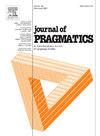不同语言形态下手掌向上张开的手势:德语和德国手语的比较
IF 1.7
1区 文学
0 LANGUAGE & LINGUISTICS
引用次数: 0
摘要
手势的使用是语言交流的一个普遍特征,这是一个公认的事实。口语和手语都是如此。然而,虽然在口语中,手势以不同于言语的方式产生(分别是视觉和声音/听觉),但手语中的手势元素以与手势相同的方式产生(都是视觉的)。本研究探讨了语言产生形态的差异是否会影响手势的语用功能。我们专注于手掌张开(PUOH)手势,并检查其在德语和DGS(德国手语)叙事作品中的使用频率和语境。我们发现德语使用者和DGS使用者使用puoh的频率相似,但在功能层面上有所不同。说话者将PUOH手势用于信息结构目的(特别是表示新的(er)信息),而手语者在话语管理层面使用PUOH手势(特别是表示叙述的结束)。我们认为,这种跨语言和跨模态的差异反映了口语和手语提供的不同启示,从而揭示了语言-手势关系的新见解,以及更普遍的语言的多模态本质。本文章由计算机程序翻译,如有差异,请以英文原文为准。
The palm-up open hand gesture across language modalities: A comparison of German and DGS (German Sign Language)
It is a well-established fact that the use of gestures is a ubiquitous feature of communication with language. This is true for both spoken and signed languages. However, while in spoken languages, gestures are produced in a different modality than speech (visual versus vocal/auditory, respectively), gestural elements in sign languages are produced in the same modality as sign (both are visual). This study investigates whether this difference in the modality of language production influences the discourse-pragmatic functions that gestures fulfill. We focus on palm-up open hand (PUOH) gestures and examine their frequency and contexts of use in German and DGS (German Sign Language) narrative productions. We find that German speakers and DGS signers use PUOHs similarly often, but differently on the functional level. Speakers deploy PUOH gestures for information structural purposes (in particular, to signal new(er) information), while signers use PUOH gestures on a discourse management level (in particular, to signal the ending of narratives). We argue that this cross-linguistic and cross-modal difference reflects the differing affordances that spoken versus signed languages offer, thereby revealing new insights into the language-gesture relationship, and the multimodal nature of language more generally.
求助全文
通过发布文献求助,成功后即可免费获取论文全文。
去求助
来源期刊

Journal of Pragmatics
Multiple-
CiteScore
3.90
自引率
18.80%
发文量
219
期刊介绍:
Since 1977, the Journal of Pragmatics has provided a forum for bringing together a wide range of research in pragmatics, including cognitive pragmatics, corpus pragmatics, experimental pragmatics, historical pragmatics, interpersonal pragmatics, multimodal pragmatics, sociopragmatics, theoretical pragmatics and related fields. Our aim is to publish innovative pragmatic scholarship from all perspectives, which contributes to theories of how speakers produce and interpret language in different contexts drawing on attested data from a wide range of languages/cultures in different parts of the world. The Journal of Pragmatics also encourages work that uses attested language data to explore the relationship between pragmatics and neighbouring research areas such as semantics, discourse analysis, conversation analysis and ethnomethodology, interactional linguistics, sociolinguistics, linguistic anthropology, media studies, psychology, sociology, and the philosophy of language. Alongside full-length articles, discussion notes and book reviews, the journal welcomes proposals for high quality special issues in all areas of pragmatics which make a significant contribution to a topical or developing area at the cutting-edge of research.
 求助内容:
求助内容: 应助结果提醒方式:
应助结果提醒方式:


